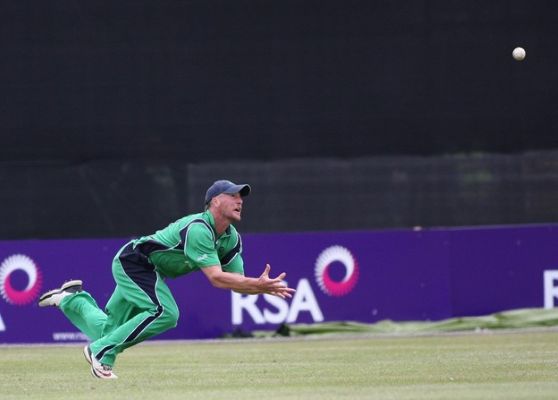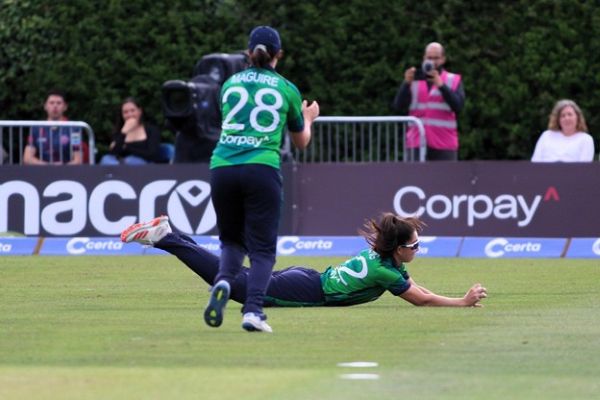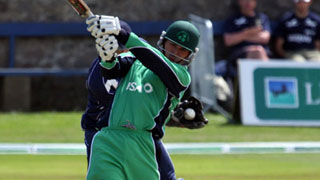Catch me if you can.
Catches win matches, the old clichés are best. Not so sure about this one though, there are nine ways to be dismissed, caught is just one of them. What might be true or truer is that dropped catches lose matches. England will rue repeated dropped catches in the utterly compelling final Test match against India at the Oval, the six dropped catches undoubtedly has an impact on the final result.
It's a fundamental movement skill. Fundamental movement skills can be defined as the “basic building blocks of movement” which can then be used to build into more complex movements. These fundamental movement skills can be broken down into these specific skills:
Walking
Running
Hopping
Skipping
Jumping
Dodging
Side stepping
Landing
Balancing
Catching
Throwing
Kicking
Striking with the hand
Striking with an implement
These basic skills inform the primary school PE curriculum in the Republic of Ireland and no doubt Northern Ireland. Seems reasonable, doesn't it?
Six or seven years ago, the school where I work was asking to be part of a study titled "Movement well - Being Well: Investigating the maturation of fundamental movement skill literacy across sex in Irish children aged five to twelve”. A group led by Stephen Behan from DCU visited the school weekly to demonstrate, observe and gather data as the students as they went through the different movements.
As adults we may look at this list and think that it's a pretty straightforward menu. I imagine that we would all fancy that we could nail each and every element, 100% top of the class. But we are talking about young children here and young children who are growing up in an environment very different to that of only a short number of years ago. Those of us who grew up playing on the streets will remember competitive games of football, services, chasing, tennis (only during Wimbledon of course) and such like. Games which developed many of those fundamental movement skills listed above, skills learnt without the pupil realising that they were learning anything at all bar survival in a game. Nowadays, playing on the road is more likely to mean hanging around outside your local Mace, checking your social media feed with a gang of mates.
Such a study has to produce results and indeed they did, top of the list of “mastery/near mastery” was, perhaps unsurprisingly, Running. Slightly more surprising was that the percentage of participants at that level was 75.3%. a percentage that leaves one wondering about the near 25% who were not able to master running. Bottom of the list was a skill fundamental to the game of cricket, that of Overhand Throw which had a percentage mastery rate of just 16%. An indicator that such skills need to be taught and practiced before mastery.
The skill which came in second was catching with a mastery of 73.5%. This took me by surprise when I went searching for the research results, I fully expected it to be much lower. Then I remembered a detail which may have had an impact. The sporting background of Behan (now Dr Stephen Behan) is in Gaelic games and this research was funded by Science Foundation Ireland and GAA’s Research and Games Development Department and Dublin GAA. Did the catching involved catching a football?, something that might be a little easier than a smaller ball, I wish I could remember to be honest.
A glance at the list of fundamental movement skills show just how important these skills are in learning the wider and more complex skills of cricket and indeed many other sports. In a race to develop “elite” cricketers at younger and younger ages, perhaps the basic building blocks are sometimes forgotten.
While an individual may be a specialist batter or bowler, everyone is a fielder in the game of cricket. And let's face it, a player is a fielder for significantly longer than they are batting or bowling. The evolution of the modern game means that unlike in years past, there is no hiding place for a poor fielder, everyone is equally exposed. Fine leg or third man were spots that the iffy fielder could be hidden but in the era of scoops, ramps, sweeps, reverse sweeps and its siblings, this is a crucial area with both run saving and catching potential.
When Adi Birrell took over as the coach to the Irish senior men’s team, he recognised quickly that improving the batting and bowling of the side would take time, techniques needed to be fixed, the quality of wickets were holding back the players, quality and number of high intensity games needed to be increased, all these aspects meant that time would be needed to raise the standards. What could be done quickly was the fielding could be improved if not overnight then quickly. There was no reason why the fielding couldn't be improved. It takes little equipment to catch and throw, sort out some biomechanics and let the individual do all the work. Repetition, repetition, repetition. That Irish side proved Adi correct, think of William Porterfield and John Mooney, two outstanding fielders.

We could talk about the wider aspects of fielding for days, well I could anyway, but it is catching that takes my fancy and is in the news after England’s poor day in the field, errors that may or may not have cost them the final Test match against India. At least six dropped catches meant that England’s final innings chase was that bit bigger than it might have been. In such a close final outcome, surely those dropped catches lost them the game? Like most skills, catching when done well looks easy. Like most skills done well, that means the individual has put in hours, years of work to make the skill look natural. For kids brought up with a ball as their primary toy, catching will come easy or easier. Exposure and repetition is the key. And confidence. If a football was used in the DCU study, it would make sense not just because of the GAA connection. Catching a football is a little easier than catching a tennis ball, that means the catcher is successful more often. Confidence grows. You will get the same result from a bean bag. Success builds confidence and confidence is key in catching.
But cricket catching is a little more complex, a hard leather ball, hit often very hard and those darn batters dont always hit it straight to you. It all adds to the complexity of the skill and let face it, it is a complex skill. The act of catching has always fascinated me. Imagine you are fielding at deep square leg, its a T20 and the batters are on the charge. The batter on strike takes a huge mow at your offie and connects. Purely from the shape of shot, you, the fielder recognise that this ball is heading in your general direction, so you can anticipate this. Of course until contact is made you cannot be sure of the exact direction but there it goes, it’s in the air, heading towards deep mid wicket, there isn’t one, so you take off, it’s your responsibility. Instantly, you set off for the direction where your brain has calculated (in a fraction of a second) that this ball is likely to land. Not just that but you set off at a pace that your brain has also calculated will get you to that landing spot in time to intercept the ball before it hits the floor. So for a couple of seconds it becomes an athletic movement. Have you ever seen GoPro footage of someone with the camera on their head? As a viewer, it is difficult to make sense of the pictures as inevitably the head wobbles at the slightest movement, at full tilt that brain of yours is hard at work again, smoothing out those pictures so you keep a clear view of the ball. Finally you get there and all you have to do is complete the catch. Suddenly catching seems the easier part. The science of it, the maths, the physics, spatial awareness, bio mechanics, neurology, decision making, anticipation are all involved in the simple act of catching a ball. Of course, the ball is travelling at a pace in these circumstances so the body has to judge the pace of the ball and the give that is needed to comfortably make the catch. There is a mathematical formula for this. No wonder it’s so difficult.

Another type of catch is the reaction one. You know the type, the hand goes up and the ball rest in it. “The more I practise the luckier I get” a saying attributed to Gary Player. The reality is that these catches aren’t lucky but are a result of years of catching a ball, the body trains itself, reactions are built up, bit by bit. Repetition, repetition, repetition. Some people make it look easy. I remember watching former West Indian cricketer Stuart Williams fielding in the slips in the 90s, it looked too easy and no one has ever called slip catching as easy pastime. In real time, I witnessed Michael Holding warming up for Derbyshire before a Nat West game against Ireland, coach whacking high catches, very high catches, to him. He seemed a bit bored as he plucked them from the sky and tossed the ball back. Similarly, before a Big Bash game in the MCG, I watched as Glenn Maxwell practised boundary catches that his coach was hitting into orbit, he mimicked stepping over the line and recatching inside the boundary as well. It is an art form when done well.

Of course, in Holding’s and Maxwell’s examples, they were just practising, there was no context beyond a warm up, a build up of confidence, getting ready for the real thing. When the real thing comes along, we have all the science bits that are described above and the added element of pressure and circumstances. Until my dying day, I will hold that the best catch that I witnessed was Brian MacNiece’s catch in the 1991 Leinster Senior Cup Final. His mate, Johnny Fitzpatrick had bowled a wide full ball which was smacked to the right of Brian. He dived full length and caught the ball one handed cleanly. It was an outstanding catch and an outstanding piece of athleticism and would qualify in anyone’s terms as a fantastic catch. There was another element, however. The batter who had smacked that ball was none other than Clontarf’s arch nemesis and the batsman with the best record in Cup Finals (particularly those involving Clontarf!). So when the ball landed in Brian’s big mitt, it meant that Alan Lewis’s part in the game was over and our path to victory was just that little bit clearer.
Let's be clear, not every catch will be taken, the best, the most diligent trainer, the best athlete, most coordinated will drop catches, possible even regularly. Here's the thing. Without any figures, whatsoever, to back the statement up, I reckon that the good fielder will drop a higher proportion of catches than the poor fielder. My logic here is that the good fielder will give themselves much more chances to take a catch, will go for the marginal opportunity and inevitably those margin chances will not always be taken. But because they make those additional efforts, their teammates and supporters will forgive them that bit quicker when the ball hits the ground. Dropping a catch is horrible. From the time the ball is airborne, all focus is on the potential catcher, if it goes to ground, all focus remains on the catcher, who just wants that ground to open up. But sport is a test of character as much as a test of skill.
The viral video which circulated a number of years ago sums up catching perfectly. The great Junior McBrine was fielding at slip for Donemena and he put down a straightforward chance. Now if you know Junior, you will know he has a great pair of hands, so this was an aberration, everyone knew but in the moments after the drop you can see the bowler deflate. The game, of course, must go on and next ball the batsman edges again and flying to his right (Junior's bad hand) the great man takes an absolute screamer. Now that's the Junior I knew
Context can only ever be the final element, you cannot practise context but you can simply practise catching the ball, again and again.
Details of the DCU study can be found at the link below:
MWBW Investigating the maturation of fundamental movement skill proficiency across sex in Irish children aged five to twelve
https://doras.dcu.ie/24189/7/MWBW%20Investigating%20the%20maturation%20of%20fundamental%20movement%20skill%20proficiency%20across%20sex%20in%20Irish%20children%20aged%20five%20to%20twelve.pdf






